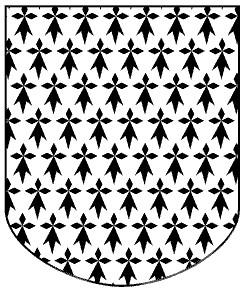Ermine: Difference between revisions
(ermine example) |
(Adding minver) |
||
| (4 intermediate revisions by 4 users not shown) | |||
| Line 1: | Line 1: | ||
One of the [[fur]]s used as a [[tincture]] ([[colour]]) in [[heraldry]]. It consists of black (''[[sable]]'') ermine spots on a white (''[[argent]]'') field. |
[[image:ermine.png|thumb|right]]One of the [[fur]]s used as a [[tincture]] ([[colour]]) in [[heraldry]]. It consists of black (''[[sable]]'') ermine spots on a white (''[[argent]]'') field. |
||
The inverse (white on black) is called ''[[counter-ermine]]'' or ''ermines''. |
The inverse (white on black) is called ''[[counter-ermine]]'' or ''ermines''. |
||
[[image:ermine.gif]] |
|||
---- |
|||
==== Natural history ==== |
|||
The ''ermine'' or short-tailed weasel, whose skins are represented by the heraldic tincture (the black spots representing either the little legs and feet, or the black-ended tail), lives in cold regions of North America and [[Europe]]. They measure about 10" plus about a 3" tail. They are yellow-brown most of the year but grow a snow-white coat in winter. Their skins were prized as [[clothing]] decoration. In this form, and without the little black feet and tai, they are aslo referred to as ''miniver'' (although this is a decorative, not not an heraldic term). |
|||
They should not be confused with the similar creature on the Discworld, the ''vermine'', a small black and white relative of the lemming, whose skin is also highly valued, not least by the vermine itself, which will do almost anything to keep possession of it. |
|||
[[Category:Device heraldry]] |
|||
Latest revision as of 21:35, 9 August 2013
One of the furs used as a tincture (colour) in heraldry. It consists of black (sable) ermine spots on a white (argent) field.
The inverse (white on black) is called counter-ermine or ermines.
Natural history
The ermine or short-tailed weasel, whose skins are represented by the heraldic tincture (the black spots representing either the little legs and feet, or the black-ended tail), lives in cold regions of North America and Europe. They measure about 10" plus about a 3" tail. They are yellow-brown most of the year but grow a snow-white coat in winter. Their skins were prized as clothing decoration. In this form, and without the little black feet and tai, they are aslo referred to as miniver (although this is a decorative, not not an heraldic term).
They should not be confused with the similar creature on the Discworld, the vermine, a small black and white relative of the lemming, whose skin is also highly valued, not least by the vermine itself, which will do almost anything to keep possession of it.
